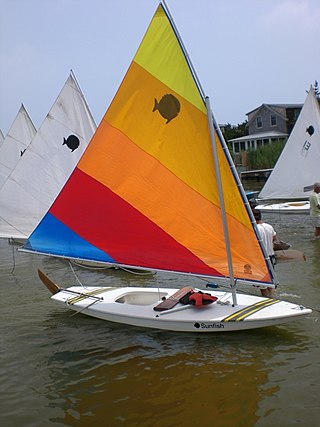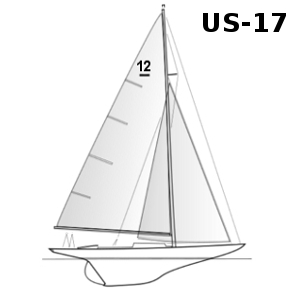
Stars & Stripes is the name of an America's Cup syndicate operated by Dennis Conner and its racing yachts, which are among the most famous in the world. The name "Stars & Stripes" refers to the nickname often used for the flag of the United States. TDC was registered under the flag of the San Diego Yacht Club (SDYC).

The Sunfish is a personal-size, beach-launched sailing dinghy. It features a very flat, boardlike hull carrying an Oceanic lateen sail mounted to an un-stayed mast.

The International 5.5 Metre class was created to yield a racing keel boat giving a sailing experience similar to that of the International 6 Metre Class, but at a lower cost.

The International Americas Cup Class is a class of racing yacht that was developed for the America's Cup between 1992 and 2007. These yachts, while not identical, were all designed to the same formula to offer designers the freedom to experiment whilst keeping the boats sufficiently comparable to race in real time. The class was established for the 1992 America's Cup because of perceived shortcomings of the 12-metre class, which had been used in the America's Cup since 1958.

The J Class of racing yachts were built to the specifications of Nathanael Herreshoff's Universal Rule. The J Class is considered the apex of the era when the Universal Rule determined eligibility in the America's Cup.
The International Offshore Rule (IOR) was a measurement rule for racing sailboats. The IOR evolved from the Cruising Club of America (CCA) rule for racer/cruisers and the Royal Ocean Racing Club (RORC) rule.
The Universal Rule determined a yacht's eligibility to race in the America's Cup from 1914 to 1937 and for this the J-class was chosen. Boats built according to the rule reached their peak in the large J-class yachts. This Rating Rule is intended to calculate a rating for yachts, which can then be used to calculate its Time Correction Factor (T.C.F.) in order to have disparate yachts racing against each other. The first boat said to be built under the universal rule was Nathanael Greene Herreshoff's Doris built in 1905.

The International rule, also known as the Metre rule, was created for the measuring and rating of yachts to allow different designs of yacht to race together under a handicap system. Prior to the ratification of the International rule in 1907, countries raced yachts under their own national rules and international competition was always subject to various forms of subjective handicapping.

The Olson 30 is a sailboat designed by George Olson of Santa Cruz, CA around 1978. Olson was a surfer and surfboard shaper who decided to design a 30' ultra light displacement boat while on a delivery from Honolulu to Santa Cruz on Merlin, a 68' Bill Lee designed and built ultralight sailboat which had competed in the biennial Transpac race in 1977. During this delivery, Olson came up with the idea while sailing with Denis Bassano and Don Snyder, who lent their initials to the prototype's name, SOB 30. The resulting boat was christened Pacific High, and it was launched in 1978.

A sailing yacht, is a leisure craft that uses sails as its primary means of propulsion. A yacht may be a sail or power vessel used for pleasure, cruising, or racing. There is no standard definition, so the term applies here to sailing vessels that have a cabin with amenities that accommodate overnight use. To be termed a "yacht", as opposed to a "boat", such a vessel is likely to be at least 33 feet (10 m) in length and have been judged to have good aesthetic qualities. Sailboats that do not accommodate overnight use or are smaller than 30 feet (9.1 m) are not universally called yachts. Sailing yachts in excess of 130 feet (40 m) are generally considered to be superyachts.
Ton classes are categories used to identify classes of yachts.

The International Seven Metre Class is a construction class, meaning that the boats are not identical but are all designed to meet specific measurement formula, in this case International Rule. At their heyday, Metre Classes were the most important group of international yacht racing classes, and they are still actively raced around the world. "Seven" in class name does not, somewhat confusingly, refer to length of the boat, but product of the formula; 7 m boats are, on average, 13 meters long.

The International Ten Metre Class is a construction class, meaning that the boats are not identical but are all designed to meet specific measurement formula, in this case International Rule. At their heyday, Metre Classes were the most important group of international yacht racing classes, and they are still actively raced around the world. "Ten" in class name does not, somewhat confusingly, refer to length of the boat, but product of the formula; 10 Metre boats are, on average, 16.5 meters long.
The International Nine Metre Class is a construction class, meaning that the boats are not identical but are all designed to meet specific measurement formula, in this case International Rule. At their heyday, Metre Classes were the most important group of international yacht racing classes, and they are still actively raced around the world. "Nine" in the class name does not, somewhat confusingly, refer to the length of the boat, but the product of the formula; 9mR boats are, on average, 18 meters long.

The IYRU Fifteen Metre class yachts are constructed to the First International rule of 1907. A total of twenty 15mR yachts were built between 1907 and 1917, the four that have survived are still actively raced.

Weatherly is a 12-metre racing yacht that was an unsuccessful defense candidate for the 1958 America's Cup and victorious defender in the 1962 America's Cup.
The following outline is provided as an overview of and topical guide to sailing:

The C&C 37/40 is a Canadian 12.05 metres (39.5 ft) LOA fibreglass monohull sailing yacht, designed in 1988 by Robert W. Ball of Cuthbertson & Cassian as a replacement for the earlier C&C 37 dating from 1981. The C&C 37/40 is a recreational keelboat of moderate displacement, intended as a cruiser/racer or oceangoing racer. The yachts have a masthead sloop rig, with a fin keel and an internally-mounted spade-type rudder. Over 110 of the 37/40 type were built before the Canadian plant closed in 1994. The design is no longer produced.

The Nonsuch 22 is a Canadian trailerable sailboat, the smallest of the series of Nonsuch sailboats. It was designed by Mark Ellis Design and first built in 1984.
Camper and Nicholson was a yacht design and manufacturing company based in Gosport, England, for over two hundred years, constructing many significant vessels, such as Gipsy Moth IV and Prince Philip's yacht Bloodhound. Its customers included Thomas Sopwith, William Kissam Vanderbilt II and George Spencer-Churchill, 6th Duke of Marlborough. Its yachts competed in The America's Cup, The Fastnet Race, the Olympics, the Ocean Race and many other yacht races. It also built a number of small warships, notably during the two World Wars, and some as late as the 1950s.


























